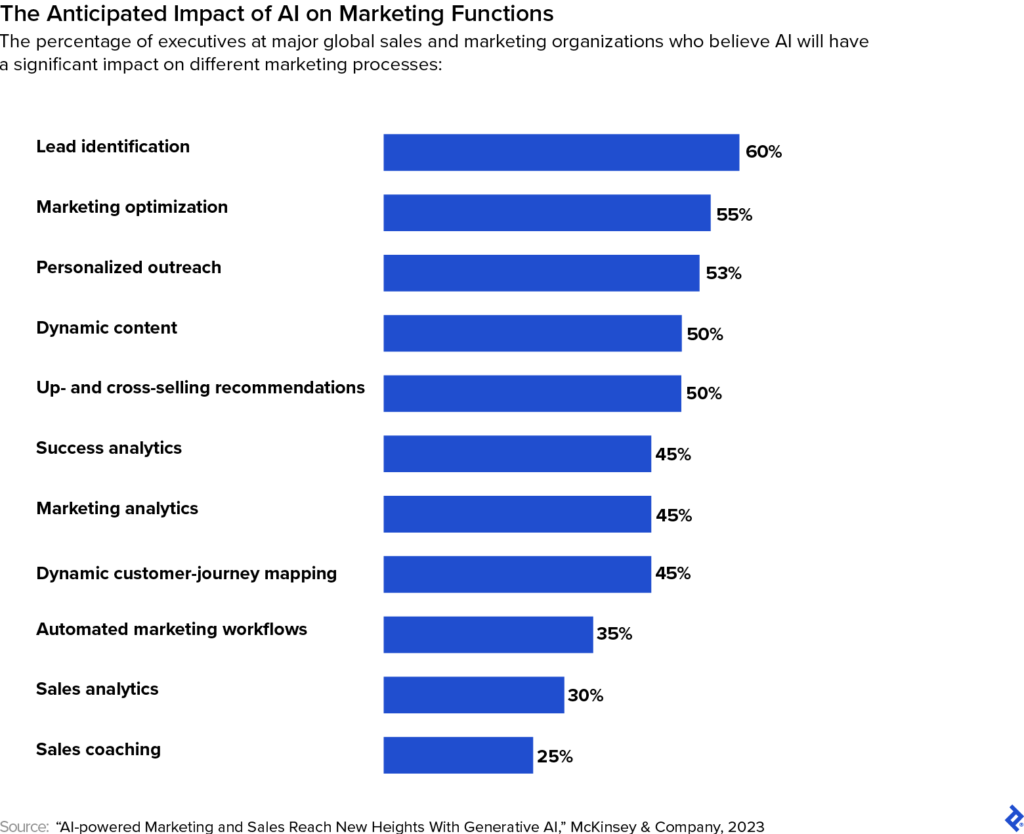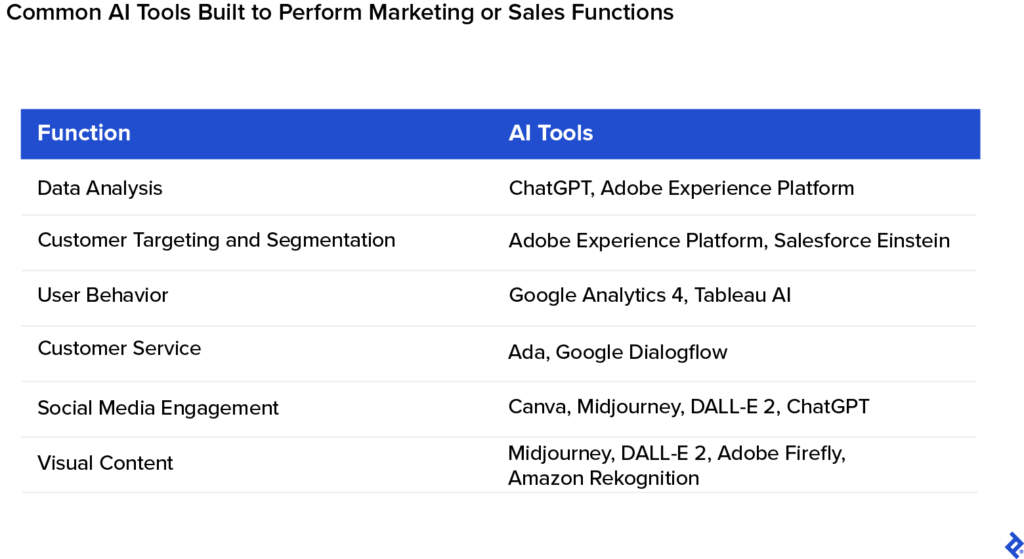The Finance Impact of AI Integration in Marketing

Transforming Marketing Budgets with AI:
Navigating Financial Benefits As startup budgets face constraints, critical marketing functions like web analytics, SEO, and email outreach are receiving smaller allocations. Explore the potential of AI to empower companies in executing these tasks with notable cost efficiencies.
Navigating Tight Startup Budgets: AI Revolutionizes Marketing Dynamics
In an era of limited startup funding, marketing may seem like a luxury, though its importance remains undeniable. Thankfully, advancements in artificial intelligence (AI) technologies can enhance the capabilities of small marketing teams. According to a survey by Bain & Company, nearly 40% of respondents from 11 industries are either using or contemplating the use of generative AI to expedite the development of marketing collateral. Moreover, a majority of global business leaders, as surveyed by McKinsey & Company, anticipate a swift adoption of AI-powered marketing tools in the next two years, with 90% expecting frequent utilization of generative AI.
Rapid Adoption of AI in Marketing: A Professional Perspective
The swift integration of artificial intelligence (AI) into marketing is propelled by the unique convergence of creative and data-driven tasks, creating a fertile ground for disruption by generative AI. As a seasoned digital marketing specialist, collaborating with startups, established businesses, and thought leaders to amplify reach and bolster sales within budget constraints, I attest to the indispensable role AI plays in enhancing the services provided. Particularly for startups, AI facilitates the execution of essential marketing tasks, including web analytics, search engine optimization, and email outreach, with unparalleled efficiency and cost-effectiveness, alleviating challenges posed by scarce funding.
The incorporation of AI tools into marketing functions, however, presents a challenge in selecting the most suitable solution for specific needs. The rapidly evolving landscape of AI offerings has business owners, even those well-versed in technology, racing to stay abreast of innovations. Notable examples, such as ChatGPT, an AI chatbot by OpenAI, have garnered immense popularity within a short timeframe, accumulating over 1.7 billion users in just one year. This exemplifies the fierce competition among major tech companies globally, each vying to lead the AI revolution with new tools and platforms.
It is imperative to recognize that AI-powered marketing platforms do not alter the fundamental goals of business marketing; instead, they revolutionize the approach to achieving those objectives. By handling routine tasks, such as real-time data analysis and autogenerating personalized marketing content, AI optimizes time and resources. However, it is crucial to acknowledge that human insight and creativity remain paramount, as AI tools lack intuitive understanding, emotional acumen, and cultural sensitivities—essential qualities for effective engagement in creative tasks, ensuring alignment with brand values, and conveying a resonant message.
This article delves into how AI can assist companies in accomplishing five key marketing objectives, starting with:
Understanding Customer Preferences
An effective marketing strategy involves tailoring messages to customer interests, behaviors, and preferences, fostering a sense of understanding and value. This personalized approach results in heightened engagement, strengthened loyalty, improved conversion rates, and ultimately increased sales.
Implementation of such a strategy encompasses data analysis, segmentation, content creation, and execution—a process often resource-intensive for smaller businesses and early-stage startups. Leveraging AI tools like ChatGPT and Adobe Experience Platform, at an annual cost ranging from $10,000 to $25,000 depending on the scope, enables efficient analysis of vast amounts of marketing data, streamlining the identification of patterns, trends, correlations, and customer preferences.

Enhancing Precision in Customer Targeting: A Professional Approach
Accurate understanding of user behavior is paramount for companies aiming to attract, acquire, and retain customers. For smaller enterprises lacking robust marketing functions, achieving this understanding often involves procuring third-party data and insights, followed by the engagement of external analysts to develop personalized content. In my professional experience, the associated costs can range from a few thousand to tens of thousands of dollars, contingent on the scope and scale of services.
A cost-effective solution to mitigate these expenses is Tableau AI, an analytics platform available at less than $100 per user per month. Tableau excels in analyzing customer behavior by benchmarking it against successful conversion paths in relevant industries. It identifies potential drop-off points, presenting a substantial opportunity for small teams to save considerable time and financial resources.
Armed with this valuable information, companies can refine their marketing tactics, implementing data-driven changes to sales processes and customer experiences. This strategic shift ensures a targeted focus on customers likely to make a purchase. This exemplifies how AI can yield cost savings by diminishing the reliance on third-party services or specialized software.
Recommended Platforms for Enhanced Customer Targeting:
- Adobe Experience Platform: Offering real-time customer segmentation and targeting, this platform, while relatively expensive at $50,000 or more annually, proves to be a worthwhile investment based on the specific needs of a company.
- Salesforce Einstein: An analytics tool seamlessly integrated with Salesforce’s customer relationship management platform, assisting businesses in automating lead scoring and customer segmentation. Pricing varies based on the Salesforce package tailored to your company’s requirements.
- Google Analytics 4: A free tool providing extensive insights into user behavior, integrating seamlessly with ad platforms. Google’s incorporation of AI to identify ads resonating most with customers makes it particularly beneficial for smaller businesses looking to enhance their advertising efforts. An enterprise-level version, Google Analytics 360, costs approximately $150,000 annually.
Efficiently Automating Customer Support: Harnessing the Power of AI
AI-driven chatbots and email bots are transformative in augmenting customer support, offering scalability, personalization, and resource optimization. Tools like ChatGPT, Ada, and Google’s Dialogflow, when appropriately guided, mimic human interactions seamlessly during support conversations.
One notable advantage of AI in customer support is its constant availability, addressing customer queries whenever assistance is required. A recent collaboration with a travel startup saw the implementation of ChatGPT to handle routine inquiries, resulting in a 30% reduction in support staff needs without compromising customer satisfaction. Another startup client, leveraging Zendesk AI and Dialogflow, achieved a 40% reduction in response time and increased customer satisfaction. These tools, equipped with virtual agents, showcase advanced ticketing and support automation beyond the capabilities of ChatGPT, operating with minimal real-time human supervision.
Ideal for small to medium-sized enterprises dealing with intricate customer queries, Zendesk AI and Dialogflow’s 24/7 availability and learning capabilities empower companies to elevate customer experiences and navigate complexity, typically at significantly lower costs compared to round-the-clock staffing.
To gauge the performance of these tools, businesses can solicit customer feedback after AI-powered interactions, using sentiment analysis to assess satisfaction levels. For complex queries outside AI training, suggestions for human interaction, email communication, or support calls can be seamlessly integrated.
Beyond basic customer support, Dialogflow extends its capabilities to craft dynamic conversational chatbots, offering personalized recommendations, handling more complex inquiries, and even facilitating sales processes. The tool’s ability to search through product databases and provide detailed product-specific information showcases its versatility.
While these AI tools enhance customer service and marketing, they do not replace the necessity of human involvement, particularly in training and customer interactions. AI serves to empower workers, allowing a shift from lead nurturing to lead qualification and activation in later stages.
Crafting Compelling Social Media Visuals: Elevating Brand Presence with AI
Establishing and maintaining a robust social media presence demands considerable time and energy, involving a continuous influx of novel ideas, vigilant monitoring, and creative collateral, such as images. AI offers substantial support in this arena. Tools like Canva’s AI image generator, Midjourney, and DALL-E 2 streamline the creation of images for social media, facilitating the development of a cohesive visual identity across platforms.
It is essential to acknowledge the contentious nature of generating images through AI-powered marketing tools. Critics argue that AI, trained on existing human-created images, may inadvertently plagiarize artists’ work. Conversely, proponents emphasize the uniqueness of each AI-generated image, with outcomes heavily dependent on human prompts. This ongoing debate extends beyond ethical considerations to regulatory aspects.
Despite this uncertainty and amidst legal challenges, the market for AI-generated images is expanding rapidly. AI-driven visual content tools—Midjourney, DALL-E 2 (integrated with Bing Chat’s Copilot), Adobe Firefly (integrated into newer versions of Photoshop), and Amazon Rekognition—generate images based on text prompts and visual examples. For companies seeking to move away from stock imagery, these tools create unique visuals aligned with a company’s brand. Continuous learning capabilities enable these tools to refine visual content generation over time, maintaining brand consistency without constant human oversight.
To address copyright and plagiarism concerns, I recommend utilizing Adobe Firefly’s image generator, drawing from Adobe’s portfolio of stock media and freely licensed images. Open AI’s DALL-E 3 provides additional protections, rejecting requests for images in the style of living artists.
Crafting Effective Email Marketing Campaigns: Streamlining Processes with AI
Traditionally, successful email marketing has entailed human involvement at every stage, necessitating coordination between writers, designers, marketing managers, and potentially IT staff. This becomes particularly resource-intensive for companies lacking in-house expertise, often requiring outsourcing of these tasks.
AI emerges as a transformative force, automating numerous email marketing processes, including audience segmentation, personalized content generation, visually appealing layout design, and A/B testing. For smaller startups on a budget, especially those in the e-commerce sector, I often recommend leveraging the free version of ChatGPT for crafting newsletter copy.
It is essential to recognize that AI tools do not negate the need for human oversight. While AI can generate marketing content based on templates, past content, brand guidelines, and audience insights, human curation remains critical. Fortunately, using AI marketing tools does not necessitate deep technical expertise, as many technologies offer user-friendly interfaces and customer support for seamless adoption by non-technical users. Collaborating with a technical team member or external expert can provide additional support for more complex implementations.
Effectively trained and deployed, AI tools offer startups and smaller companies the ability to generate impactful marketing materials at a fraction of the cost associated with a full marketing team or external vendors. Experimenting with these tools and identifying those aligning best with business objectives can reveal AI’s capability to alleviate the burden of routine marketing tasks, enabling individuals to focus on strategic insight and creativity.
For further insights, explore additional articles on the Toptal Blog, covering topics such as crafting successful go-to-market strategies, increasing back-office efficiency through automation, building compelling financial models, and navigating the challenges of initial market entry.
AUTHOR’S PROFILE
Asset is a seasoned digital performance marketer with a focus on B2B lead generation and digital strategy. With a track record of leading successful marketing campaigns for both Fortune 500 companies and startups alike, he has effectively managed budgets exceeding $600,000. Asset holds a bachelor’s degree in economics and business, complemented by a master’s in strategic marketing from Imperial College Business School in London.
Jobswifi authors, including Asset, are distinguished experts in their respective fields, contributing insightful content based on their demonstrated expertise. All our content undergoes a thorough peer review process, ensuring validation by Jobswifi experts within the same domain.

